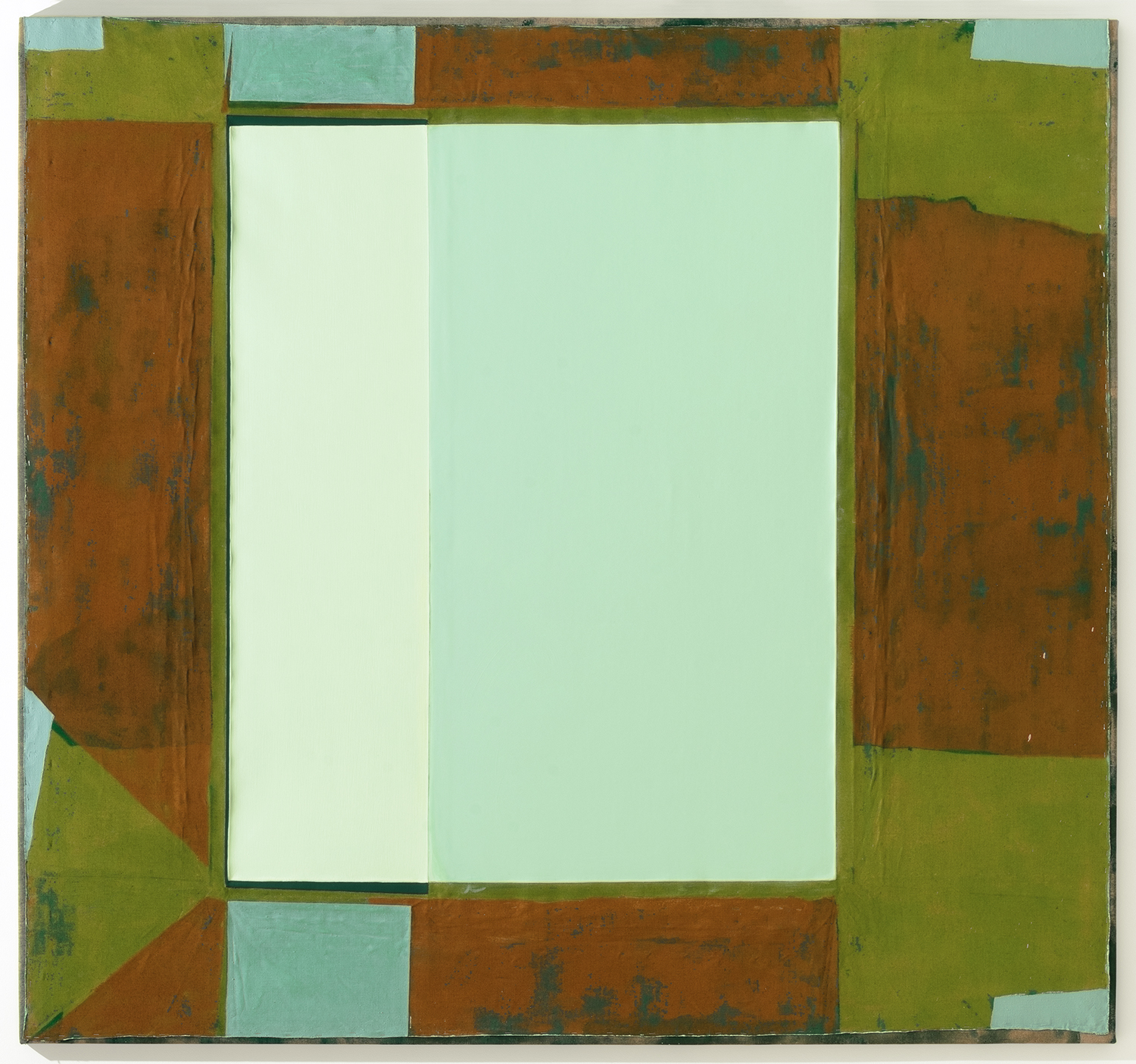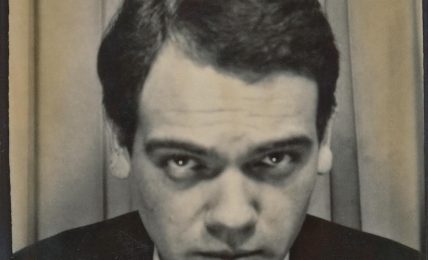In this interview, Xavier McFarlin talks about the process behind his artistic decisions as well as his experience growing up in Japan as a Mexican, Queer, Black, male and how the cultural difference has influenced his work. He also talks about his works, Black Portrait 1, and Black Portrait 2, in reference to the works of Fred Morten.
DigA: BlackPortrait 1 and Black Portrait 2 (2018) depict a figure completely covered in black, except for the lips and eyes, against a green screen. The images nod to the racist history of blackface, to the poignant works of Kara Walker, and to the fake “magic” of digital film. In other pieces, like (White) Out (2019) the figure’s skin is painted blue. As the body, and the background, become a canvas, what is your process for choosing body color, and does that choice impact the scene in which you place yourself?
Xavier McFarlin: I often feel the burden of representation when making critiques of race in America, as someone who is so new to the United States. I use images and my body to create visual representations of how I feel about blackness and queer identity in contrast to the “all American” narrative. Through this, I envision myself as the other in sterile spaces. (White) Out is about reduction of image in the all white office space. Frustration is a common feeling in a lot of my work and spaces I’ve created while thinking about color. I used my body as an object, image and color to understand my bodies relationship to technology.
My body is an image in itself, representationally and functioning as an object in photography. I use the color blue (black) in reference to Fred Morten’s Black and Blur, and to reference technology. The body colors function as camouflage. I choose to work within blue to represent technology and blue(black)ness. The set design is representative of my conflicting multiple identities and the ability to constantly adapt to new surroundings while concurrently standing out from these spaces.
The background is representative of the simulation in which the cyborg is interacting within. My frustration with visuality within the work is about the generalization of race coming to the United States and confronting that generalization by reclaiming my image. Black Portrait, was created through the process of editing within photoshop. I selected all of the green surfaces in the image and inverted the selection to select just the figure. Instead of getting rid of the green, I redacted my image, and without that image, there is a gap.
DigA: In Negro Horse (2018), there is a tension between the jump of the figure with the forward motion of the horse. While the figure rises, we anticipate their fall as the horse leaps through the body of the frame. What does it take for an image to be accepted into the body frame in this and Masc(ing) (2018)? What do you hope to achieve with the viewer?
XM: Masc(ing) is a play on words of the photoshop technique of masking an image, and covering up aspects in order to correct an image and masculinity in society. A process of fixing is used within photography to make corrections and alter the original. Fixing an image in the darkroom is a process of washing an image in order for the image to darken and come into view without fogginess. I am exposing the corrections I would of made in the image of the western cyborg and creating layers of a white male in a rodeo with a black bull. Highlighting and transitioning specific elements of the photographs for example, the bull’s hoof is opaque to the cyborg’s palm as if the male is riding the cyborg in the image. Layers and textures with this work create a visual complexity between the foreground and the background.
As a queer maker and thinker, I make images to represent my own perception of my image and substitute actual backgrounds for constructed set designs. Other forms of construction being race, gender and culture, exist as hierarchical ways of categorizing one from the other. I am using stereotypical images of brute masculinity and dominance layered on top of my body to show the erasure between images. I want there to be a constant push and pull of color, and understanding what color can signify in all facets of identity, between the white male figure, the grey in between black and white and the color of my brown skin.
DigA: You clearly play with cultural stereotypes in your work, and we can see the influence of your childhood in Japan in Idle-ize (2019). Can you talk a bit about how your childhood in Japan influences the scenes and characters you create?
XM: Growing up as a Queer Black/ Latino child in Japan, culturally, I adopted and understood levels of Japanese culture. In relationship to a part of my nationality being in Japan, I am constantly at war with the feeling of being a “外人”( Gai-jin – outsider), yet appreciated when conforming to Japanese cultural ideals. Japan is a very homogeneous country, which was scary, new and exciting. I had experiences where I did feel idolized for being different, which at the time I didn’t quite understand. There was a fascination Japanese people had with my hair and my image. Their fascination was an attempt to get to know more about who I was. My upbringing in Japan has a major influence on my practice from the influence of pop culture, desire, fantasy and simulation in my process of making work. I often think about anime within my work and how the characters don’t have a specific nationality yet, resemble westerners with a variety of hair colors.
More specifically, I thought about the amount of influence icons, be it cartoon characters or pop music artists, have on visual culture in Japan within advertising and marketing. Objects all over Japan have characters on them to support the sell of their products, depending on the popularity of one character over the other. In each image I am thinking about my character’s relationship to the space and their ability to shift the perspective of that image.
DigA: Keeping with the cultural theme, you moved from Japan to Texas at 18. And again, pieces like Masc(ing) evoke a sense of place a nod to the culture found there. How do you contrast your time in Texas with Japan and (currently) New York? Perhaps more succinctly, how does the accumulation of place influence each image?
XM: Coming to the United States as an adult shifted my perspective on race, gender, class, and culture. I am someone who identifies as Mexican, Black, Queer and male; each word is a category for how I represent myself. With my work I’m starting to piece together a fragmented self that looks towards future possibilities, similar to the Queer Afro-Futurists whose identities are not limited by the roots of colonial oppression. I project my vision of self beyond the earthly matters that limit my ability to recreate myself on a continual basis.
Each image is a representation of contrasting cultures which have informed my ability to adapt. Functioning nomadically and growing up on and off of military bases for the majority of my life, I was constantly living within simulated communities. These communities can often feel isolating, strategic and conservative. Traveling within the U.S. has shifted my perspective on identity in the last six years, living in Texas, California and New York. I am hyperaware of social dynamics in accordance with how my image functions and I definitely play on the perception of how I am seen through each character. Moving through these spaces quickly asks for a new way of thinking about space and its influence on perceptions of self image.
Blending into space by way of camouflage is a survival tactic, and I use chroma to understand what it means to take on many different aspects that make up my perspective on blackness. Survival is to live past a history that has subverted your capability to live, and embracing the future is a way of surviving and seeing the self in the future. The self is imagined in multiple worlds and cannot only function in a theoretical space, but it is a space created for blackness to be pushed forward. Pushed forward past the generalization of the one-sided perspective of what blackness is or can be.
DigA: There is a consistent, compelling character throughout your pieces. Can you talk about how they came about, and where they may be going next?
XM: The character throughout all of my work happened through a process of trying to perform different aspects of my identity, and the instability of multiple identities. I am constantly performing, camouflaging myself within the American landscape and making space for myself as a third culture child. Third Culture Children are people who are born in one country, grow up in another country and return to a country of citizenship. It’s a very detached and isolating experience when returning to the United States. It is difficult to challenge popular preconceptions of identity in America. I enjoy having fun with these characters, playing with perceptions of my image and seeing how far I can push the desire for the other into the near future.
You can view McFarlin’s selected works here.
:::




